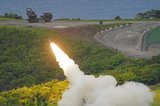AUVSI: PCAS reaches first design review
DARPA’s Persistent Close Air Support (PCAS) programme has completed its first Conceptual Design Review with mission systems integrator Raytheon describing aspirations for a ‘cross-service’ capability for current and future manned and unmanned air frames.
Speaking to Shephard ahead of the Unmanned Systems North America exposition in Washington, DC, Raytheon officials said findings from a series of trade studies had made PCAS relevant to marines, soldiers, sailors and airmen.
In April, Raytheon and Northrop Grumman were awarded $7m contracts by DARPA to develop the next-generation of Joint Terminal Attack Controller (JTAC) equipment and CONOPS relating to airborne sensors and weapons. The four-year programme includes an 18-month lead up to a Preliminary Design Review including a Systems Requirement Review scheduled for September ahead of a Phase 2-3 Programme Review in June 2012.
DARPA is then expected to down-select either Northrop Grumman or Raytheon to continue with the second phase in October 2012. The programme will use an unmanned A-10 Thunderbolt II or ‘Warthog’ for the demonstration in 2015.
However, it is envisaged that PCAS will be relevant to the USAF’s MQ-X next-generation UAV, which would replace in-service MQ-1 and MQ-9 Predator and Reaper UAVs is scheduled for 2019, Bossert added.
‘We are in the midst of trade studies and have found a broad applicability beyond JTACs. For example, anybody in the field that needs to produce an effect, be they Joint Fires Observers (JFOs) or Forward Air Controllers (FACs). There is a cross-service applicability which requires flexibility in design,’ senior engineering fellow for unmanned systems at Raytheon, Dave Bossert told Shephard.
Stressing the importance of including legacy equipment, Raytheon told Shephard that it was considering all radio equipment used by dismounted troops including AN/PRC-117G, AN/PRC-152, AN/PRC-148 as well as Link 16 military tactical data exchange network.
In collaboration with Rockwell Collins, Raytheon is also considering various computers, laser rangefinders and angulation devices as well as a variety of power sources for mission profiles up to 36 hours.
Unable to comment on which particular units with the US armed forces it was dealing with, Bossert admitted: ‘We are talking to the army, JFO personnel and the whole close air support community. We have to develop open architecture to interface with existing and future systems such as the Gen 4 Litening Pod as used for F-15 and F-16s. We are not tied to specific platforms.’
Essentially, the programme is designed to decrease the timeline for CAS missions, Bossert explained. ‘It’s all about shared situation awareness. We want the JTAC to be able to understand what weapons are available on the UAS as well as their effect. He can cycle through each and see graphically its effects on the ground.
‘Targets will be digitally injected into the system and seen on a map and the UAS operator will see the weapon selected by the JTAC. Anybody can override ant any point,’ he continued. It is understood that DARPA is considering four munitions including the JDAM, Laser Maverick, 2.75-in rocket and gun.
More from Uncrewed Vehicles
-
![What's next for the Pentagon after the Replicator programme?]()
What's next for the Pentagon after the Replicator programme?
Although the Replicator initiative has made several accomplishments, there are still multiple gaps to plug across the US Department of Defense (DoD) and its services.
-
![Cummings Aerospace showcases Hellhound loitering munition designed for US Army’s LASSO programme (video)]()
Cummings Aerospace showcases Hellhound loitering munition designed for US Army’s LASSO programme (video)
Cummings Aerospace presented its turbojet-powered Hellhound loitering munition at SOF Week 2025, offering a man-portable solution aligned with the US Army’s LASSO requirements.
-
![SOF Week 2025: PDW unveils attritable FPV drone for SOF operations at scale]()
SOF Week 2025: PDW unveils attritable FPV drone for SOF operations at scale
PDW has revealed its Attritable Multirotor First Person View drone at SOF Week 2025, offering special operations forces a low-cost, rapidly deployable platform for strike and ISR missions, inspired by battlefield lessons from Ukraine.
-
![SOF Week 2025: Teledyne FLIR white paper provides guidance on reusable loitering munitions]()
SOF Week 2025: Teledyne FLIR white paper provides guidance on reusable loitering munitions
Teledyne FLIR is highlighting the emerging requirements for 'recoverable and re-usable' loitering munitions across the contemporary operating environment during this week’s SOF Week conference in Tampa, Florida.
-
![SOF Week 2025: Kraken Technology group debuts K3 Scout USV in North America]()
SOF Week 2025: Kraken Technology group debuts K3 Scout USV in North America
High-performance maritime industry player Kraken Technology Group, based in the UK, has used the SOF Week conference in Tampa, Florida this week to debut its K3 Scout uncrewed surface vessel (USV) to the North American market.
-
![Palladyne AI and Red Cat to demonstrate capabilities for autonomous drone swarms to the US military]()
Palladyne AI and Red Cat to demonstrate capabilities for autonomous drone swarms to the US military
Red Cat and Palladyne AI recently conducted a cross-platform collaborative flight involving three diverse heterogeneous drones.

























